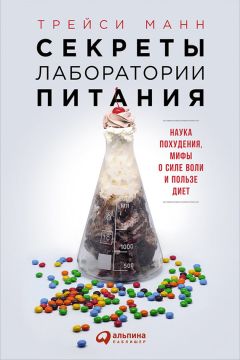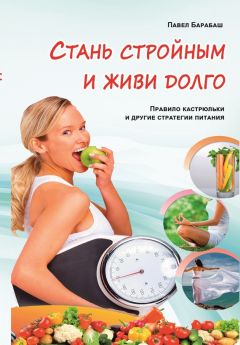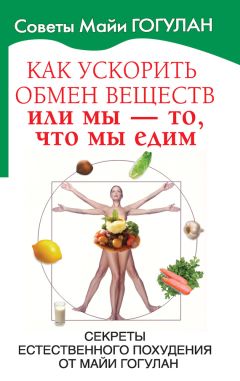Трейси Манн - Секреты лаборатории питания. Наука похудения, мифы о силе воли и пользе диет
37. J. J. Varo et al., “Distribution and Determinants of Sedentary Lifestyles in the European Union”, International Journal of Epidemiology 32, no. 1 (February 1, 2003): 138-46, doi:10.1093/ije/dygll6.
38. Там же.
39. Casazza et al., “Myths, Presumptions, and Facts about Obesity”.
40. Phillipa Caudwell et al., “Exercise Alone Is Not Enough: Weight Loss Also Needs a Healthy (Mediterranean) Diet?”, Public Health Nutrition 12, no. 9A (September 1, 2009): 1663-66, doi: 10.1017/ S1368980009990528.
41. Scott M. Grundy et al., “Clinical Management of Metabolic Syndrome: Report of the American Heart Association/National Heart, Lung, and Blood Institute / American Diabetes Association Conference on Scientific Issues Related to Management”, Circulation 109, no. 4 (February 3, 2004): 551-56, doi:10.1161/01.CIR.0000112379.88385.67.
42. D. E. Thomas, E. J. Elliott, and G. A. Naughton, “Exercise for Type 2 Diabetes Mellitus”, Evidence-Based Nursing 10, no. 1 (2007): 11.
43. Balraj S. Heran et al., “Exercise-Based Cardiac Rehabilitation for Coronary Heart Disease”, Cochrane Database of Systematic Reviews no. 7 (January 2011): CD001800, doi:10.1002/14651858.CD001800.pub2.
44. Paul D. Thompson et al., “Exercise and Physical Activity in the Prevention and Treatment of Atherosclerotic Cardiovascular Disease: A Statement from the Council on Clinical Cardiology (Subcommittee on Exercise, Rehabilitation, and Prevention) and the Council on Nutrition, Physical Activity, and Metabolism (Subcommittee on Physical Activity)”, Circulation 107, no. 24 (June 24, 2003): 3109-16, doi:10.1161/01. CIR.0000075572.40158.77.
45. Sean Carroll and Mike Dudfield, “What Is the Relationship between Exercise and Metabolic Abnormalities?”, Sports Medicine 34, no. 6 (2004): 371-418, doi: 10.2165/00007256-200434060-00004.
46. Martha L. Slattery and John D. Potter, “Physical Activity and Colon Cancer: Confounding or Interaction?”, Medicine and Science in Sports and Exercise 34, no. 6 (June 2002): 913-19.
47. Rosalind A. Breslow et al., “Long-Term Recreational Physical Activity and Breast Cancer in the National Health and Nutrition Examination Survey I Epidemiologic Follow-up Study”, Cancer Epidemiology, Biomarkers & Prevention 10, no. 7 (July 1, 2001): 805-8.
48. Casazza et al., “Myths, Presumptions, and Facts about Obesity”; Breslow et al., “Long-Term Recreational Physical Activity and Breast Cancer in the National Health and Nutrition Examination Survey I
Epidemiologic Follow-up Study”; Grundy et al., “Clinical Management of Metabolic Syndrome”; Thomas, Elliott, and Naughton, “Exercise for Type 2 Diabetes Mellitus”; Caudwell et al., “Exercise Alone Is Not Enough”.
49. S. N. Blair and T. S. Church, “The Fitness, Obesity, and Health Equation: Is Physical Activity the Common Denominator?”, JAMA 292, no. 10 (2004): 1232-34, doi:10.1001/jama.292.10.1232; S. N. Blair and S. Brodney, “Effects of Physical Inactivity and Obesity on Morbidity and Mortality: Current Evidence and Research Issues”, Medicine & Science in Sports & Exercise 31, no. 11 Suppl. (1999): S646-62; M. Fogelholm, “Physical Activity, Fitness and Fatness: Relations to Mortality, Morbidity and Disease Risk Factors: A Systematic Review”, Obesity Reviews 11, no. 3 (2010): 202-21, doi:10.1111/j.l467-789X.2009.00653.x; M. Wei et al., “Relationship between Low Cardiorespiratory Fitness and Mortality in Normal-Weight, Overweight, and Obese Men”, JAMA 282, no. 16 (1999): 1547-53.
50. Paul McAuley et al., “Fitness and Fatness as Mortality Predictors in Healthy Older Men: The Veterans Exercise Testing Study”, Journals of Gerontology: Series A, Biological Sciences and Medical Sciences 64, no. 6 (June 1, 2009): 695-99, doi:10.1093/gerona/gln039.
51. Caitlin Mason et al., “History of Weight Cycling Does Not Impede Future Weight Loss or Metabolic Improvements in Postmenopausal Women”, Metabolism: Clinical and Experimental 62, no. 1 (January 1, 2013): 127-36, doi: 10.1016/j.metabol.2012.06.012.
52. Nancy E. Adler and Joan M. Ostrove, “Socioeconomic Status and Health: What We Know and What We Don’t”, Annals of the New York Academy of Sciences 896, no. 1 (December 6, 1999): 3-15, doi: 10.1111/j.1749-6632.1999.tb08101.x.
53. M. G. Marmot, M. J. Shipley, and G. Rose, “Inequalities in Death — Specific Explanations of a General Pattern?”, Lancet 1, no. 8384 (May 5, 1984): 1003-1006.
54. Adler and Ostrove, “Socioeconomic Status and Health”.
55. U.S. Department of Health and Human Services, Office of Disease Prevention and Health Promotion, Healthy People 2020 (Washington, DC, 2010).
56. Для ознакомления с отличным обзором по теме см.: Karen А. Matthews and Linda С. Gallo, “Psychological Perspectives on Pathways Linking Socioeconomic Status and Physical Health”, Annual Review of Psychology 62 (January 2011): 501-30, doi:10.1146/annurev. psych.031809.130711.
57. Bruce S. McEwen and Teresa Seeman, “Protective and Damaging Effects of Mediators of Stress: Elaborating and Testing the Concepts of Allostasis and Allostatic Load”, Annals of the New York Academy of Sciences 896, no. 1 (December 6, 1999): 30-47, doi:10.1111/j.1749-6632.1999. tb08103.x.
58. K. E. Pickett and M. Pearl, “Multilevel Analyses of Neighbourhood Socioeconomic Context and Health Outcomes: A Critical Review”, Journal of Epidemiology and Community Health 55, no. 2 (February 2001): 111-22.
59. Youfa Wang and May A. Beydoun, “The Obesity Epidemic in the United States — Gender, Age, Socioeconomic, Racial/Ethnic, and Geographic Characteristics: A Systematic Review and Meta-Regression Analysis”, Epidemiologic Reviews 29, no. 1 (January 1, 2007): 6-28, doi:10.1093/ epirev/mxm007; J. Sobal and A. J. Stunkard, “Socioeconomic Status and Obesity: A Review of the Literature”, Psychological Bulletin 105, no. 2 (1989): 260-75.
60. Jacob J. Feldman et al., “National Trends in Educational Differentials in Mortality”, American Journal of Epidemiology 129, no. 5 (May 1, 1989): 919-33; M. G. Marmot et al., “Health Inequalities among British Civil Servants: The Whitehall II Study”, Lancet 337, no. 8754 (June 8, 1991): 1387-93; Marmot, Shipley, and Rose, “Inequalities in Death — Specific Explanations of a General Pattern?”; H. Bosma et al., “Low Control Beliefs, Classical Coronary Risk Factors, and Socio-Economic Differences in Heart Disease in Older Persons”, Social Science & Medicine 60, no. 4 (2005): 737-45.
61. National Institutes of Health, U.S. Department of Health and Human Services, “What Is Metabolic Syndrome?”, Health Information for the Public, accessed November 5, 2013, http://www.nhlbi.nih.gov/health/ health-topics/topics/ms/.
62. Thais Coutinho et al., “Combining Body Mass Index with Measures of Central Obesity in the Assessment of Mortality in Subjects with Coronary Disease: Role of‘Normal Weight Central Obesity’”, Journal of the American College of Cardiology 61, no. 5 (February 5, 2013): 553-60, doi:10.1016/j.jacc.2012.10.035; Thais Coutinho et al., “Central Obesity and Survival in Subjects with Coronary Artery Disease: A Systematic Review of the Literature and Collaborative Analysis with Individual Subject Data”, Journal of the American College of Cardiology 57, no. 19 (May 10, 2011): 1877-86, doi:10.1016/j. jacc.2010.11.058; Halfdan Petursson et al., “Body Configuration as a Predictor of Mortality: Comparison of Five Anthropometric Measures in a 12 Year Follow-up of the Norwegian HUNT 2 Study”, ed. Stefan Kiechl, PloS One 6, no. 10 (January 2011): e26621, doi:10.1371/ journal.pone.0026621.
63. Coutinho et al., “Central Obesity and Survival in Subjects with Coronary Artery Disease”.
64. Elizabeth A. Pascoe and Laura Smart Richman, “Perceived Discrimination and Health: A Meta-Analytic Review”, Psychological Bulletin 135, no. 4 (2009): 531-54.
65. R. M. Puhl and C. A. Heuer, “The Stigma of Obesity: A Review and Update”, Obesity (Silver Spring, MD) 17, no. 5 (2009): 941-64, doi:10.1038/oby.2008.636.
66. Drew A. Anderson and Thomas A. Wadden, “Bariatric Surgery Patients’ Views of Their Physicians’ Weight-Related Attitudes and Practices”, Obesity Research 12, no. 10 (October 2004): 1587-95, doi:10.1038/ oby.2004.198.
67. Rebecca M. Puhl and Kelly D. Brownell, “Confronting and Coping with Weight Stigma: An Investigation of Overweight and Obese Adults”, Obesity (Silver Spring, MD) 14, no. 10 (October 2006): 1802-15, doi:10.1038/oby.2006.208.
68. N. K. Amy et al., “Barriers to Routine Gynecological Cancer Screening for White and African-American Obese Women”, International Journal of Obesity 30, no. 1 (January 4, 2006): 147-55, doi:10.1038/ sj.ijo.0803105.
69. G. D. Foster et al., “Primary Care Physicians’ Attitudes about Obesity and Its Treatment”, Obesity Research 11, no. 10 (2003): 1168-77, doi:10.1038/oby.2003.161.
70. M. B. Schwartz et al., “Weight Bias among Health Professionals Specializing in Obesity”, Obesity Research 11, no. 9 (2003): 1033-39.
71. M. R. Hebl and J. Xu, “Weighing the Care: Physicians’ Reactions to the Size of a Patient”, International Journal of Obesity and Related Metabolic Disorders 25, no. 8 (August 2001): 1246-52, doi: 10.1038/ sj.ijo.0801681.
72. Kimberly A. Gudzune et al., “Physicians Build Less Rapport with Obese Patients”, Obesity (Silver Spring, MD) 21, no. 10 (March 20, 2013): 2146-52, doi:10.1002/oby.20384.
73. David Р. Miller et al., “Are Medical Students Aware of Their Anti-Obesity Bias?”, Academic Medicine 88, no. 7 (July 2013): 978-82, doi:10.1097/ ACM.0b013e318294f817; Sean M. Phelan et al., “Implicit and Explicit Weight Bias in a National Sample of 4,732 Medical Students: The Medical Student CHANGES Study”, Obesity (Silver Spring, MD) (2013), doi:10.1002/oby.20687.
74. Kimberly A. Gudzune et al., “Doctor Shopping by Overweight and Obese Patients Is Associated with Increased Healthcare Utilization”, Obesity (Silver Spring, MD) 21, no. 7 (July 2013): 1328-34, doi:10.1002/ oby.20189.
75. T. Ostbye et al., “Associations between Obesity and Receipt of Screening Mammography, Papanicolaou Tests, and Influenza Vaccination: Results from the Health and Retirement Study (HRS) and the Asset and Health Dynamics among the Oldest Old (AHEAD) Study”, American Journal of Public Health 95, no. 9 (2005): 1623-30, doi: 10.2105/ AJPH.2004.047803; С. C. Wee et al., “Screening for Cervical and Breast Cancer: Is Obesity an Unrecognized Barrier to Preventive Care?”, Annals of Internal Medicine 132, no. 9 (2000): 697-704.
76. Ostbye et al., “Associations between Obesity and Receipt of Screening Mammography, Papanicolaou Tests, and Influenza Vaccination”; Wee et al., “Screening for Cervical and Breast Cancer”.
77. Jeanne M. Ferrante et al., “Colorectal Cancer Screening among Obese Versus Non-Obese Patients in Primary Care Practices”, Cancer Detection and Prevention 30, no. 5 (2006): 459-65; Allison B. Rosen and Eric C. Schneider, “Colorectal Cancer Screening Disparities Related to Obesity and Gender”, Journal of General Internal Medicine 19, no. 4 (April 2004): 332-38, doi:10.1111/j.l525-1497.2004.30339.x.
78. Ostbye et al., “Associations between Obesity and Receipt of Screening Mammography, Papanicolaou Tests, and Influenza Vaccination”.
79. Pascoe and Richman, “Perceived Discrimination and Health”.
80. B. Major, D. Eliezer, and H. Rieck, “The Psychological Weight of Weight Stigma”, Social Psychological and Personality Science 3, no. 6 (January 19, 2012): 651-58, doi: 10.1177/1948550611434400. Cm. также: Janet Tomiyama et al., “Associations of Weight Stigma with Cortisol and Oxidative Stress Independent of Adiposity”, Health Psychology 33, no. 8 (August 2014): 862-67, doi:10.1037/hea0000107. Другой пример можно найти в работе: Natasha A. Schvey, Rebecca M. Puhl, and Kelly D. Brownell, “The Stress of Stigma: Exploring the
Effect of Weight Stigma on Cortisol Reactivity”, Psychosomatic Medicine (2014): PSY-0000000000000031.
81. Puhl and Brownell, “Confronting and Coping with Weight Stigma”.
82. Jenny H. Ledikwe et al., “Dietary Energy Density Is Associated with Energy Intake and Weight Status in US Adults”, American Journal of Clinical Nutrition 83, no. 6 (June 2006): 1362-68.
83. Lawrence de Koning et al., “Sugar-Sweetened and Artificially Sweetened Beverage Consumption and Risk of Type 2 Diabetes in Men”, American Journal of Clinical Nutrition 93, no. 6 (June 1, 2011): 1321-27, doi: 10.3945/ajcn.l 10.007922. Koning.
84. Ankur Vyas et al., “Diet Drink Consumption and the Risk of Cardiovascular Events: A Report from the Women’s Health Initiative”, Journal of the American College of Cardiology 63, no. 12 (April 1, 2014): A1290, doi:10.1016/S0735-1097(14)61290-0. vyas.
85. Jotham Suez et al., “Artificial Sweeteners Induce Glucose Intolerance by Altering the Gut Microbiota”, Nature (September 17, 2014), doi:10.1038/naturel3793. Suez.
86. A. S. Levy and A. W. Heaton, “Weight Control Practices of US Adults Trying to Lose Weight”, Annals of Internal Medicine 119, no. 7 Part 2 (1993): 661-66; Edward C. Weiss et al., “Weight-Control Practices among U.S. Adults, 2001-2002”, American Journal of Preventive Medicine 31, no. 1 (2006): 18-24.
87. Lisa L. Ioannides-Demos et al., “Safety of Drug Therapies Used for Weight Loss and Treatment of Obesity”, Drug Safety 29, no. 4 (2006): 277-302, doi: 10.2165/00002018-200629040-00001.
88. M. A. Whisman, “Loneliness and the Metabolic Syndrome in a Population-Based Sample of Middle-Aged and Older Adults”, Health Psychology 29, no. 5 (2010): 550-54, doi:10.1037/a0020760.
89. J. Holt-Lunstad, T. B. Smith, and J. B. Layton, “Social Relationships and Mortality Risk: A Meta-Analytic Review”, PLoS Med 7, no. 7 (2010): el000316,doi:10.1371/journal.pmed. 1000316.
90. Сведения взяты из дополнительных материалов к статье. Вебадреса, по которому можно выйти на эти данные, не существует, но их можно найти в основной статье: Flegal et al., “Association of All-Cause Mortality with Overweight and Obesity Using Standard Body Mass Index Categories”.




